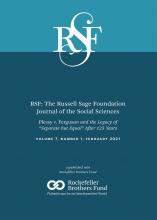Research Article
Open Access
Separate and Unequal Under One Roof: How the Legacy of Racialized Tracking Perpetuates Within-School Segregation
Dania V. Francis, William A. Darity, Jr.
RSF: The Russell Sage Foundation Journal of the Social Sciences February 2021, 7 (1) 187-202; DOI: https://doi.org/10.7758/RSF.2021.7.1.11
Dania V. Francis
aAssistant professor of economics at the University of Massachusetts Boston, United States
William A. Darity Jr.
bSamuel DuBois Cook Professor of Public Policy, African and African American Studies, and Economics and the director of the Samuel DuBois Cook Center on Social Equity at Duke University, United States

REFERENCES
- ↵
- Andrews, Rodney J., and
- Omari H. Swinton
- ↵
- Archbald, Doug,
- Joseph Glutting, and
- Xiaoyu Qian
- ↵
- Austen-Smith, David, and
- Roland G. Fryer
- ↵
- Caraway, Kirsten,
- Carolyn M. Tucker,
- Wendy M. Reinke, and
- Charles Hall
- ↵
- ↵
- Clotfelter, Charles T.,
- Helen F. Ladd, and
- Jacob L. Vigdor
- ↵
- ↵
- Conger, Dylan
- ↵
- Conger, Dylan,
- Mark C. Long, and
- Patrice Iatarola
- ↵
- Cook, Philip J., and
- Jens Ludwig
- ↵
- Cose, Ellis
- ↵
- Darity, William, Jr.., and
- Alicia Jolla
- ↵
- ↵
- Diamond, John B
- ↵
- Diette, Timothy M.,
- Darrick Hamilton,
- Arthur H. Goldsmith, and
- William A. Darity Jr.
- ↵
- ↵
- ↵
- Fryer, Roland G., and
- Paul Torelli
- ↵
- Gershenson, Seth,
- Stephen B. Holt, and
- Nicholas W. Papageorge
- ↵
- Gonzalez, Naihobe
- ↵
- Hale, Janice E
- ↵
- Harris, Angel
- ↵
- ↵
- Klopfenstein, Kristin
- ↵
- ↵
- Noguera, Pedro A
- ↵
- Oakes, Jeannie
- ↵
- Office for Civil Rights
- ↵
- Ogbu, John U
- ↵
- Pattillo, Mary
- ↵
- ↵
- Shedd, Carla
- ↵
- Smith, Jonathan,
- Michael Hurwitz, and
- Christopher Avery
- ↵
- Tatum, Beverly Daniel
- ↵
- Tyson, Karolyn
- ↵
- Tyson, Karolyn,
- William Darity Jr.., and
- Domini R. Castellino
- ↵
- West, Kimberly C
- ↵
- Wilson, William Julius
- ↵
- Yonezawa, Susan,
- Amy Stuart Wells, and
- Irene Serna
In this issue
Separate and Unequal Under One Roof: How the Legacy of Racialized Tracking Perpetuates Within-School Segregation
Dania V. Francis, William A. Darity
RSF: The Russell Sage Foundation Journal of the Social Sciences Feb 2021, 7 (1) 187-202; DOI: 10.7758/RSF.2021.7.1.11
Jump to section
Related Articles
- No related articles found.
Cited By...
- No citing articles found.





